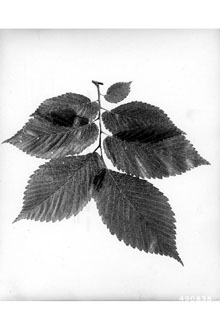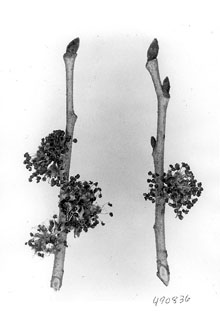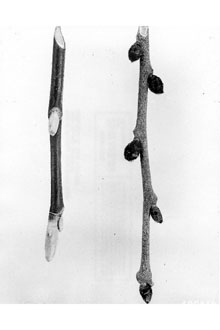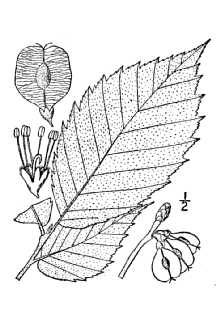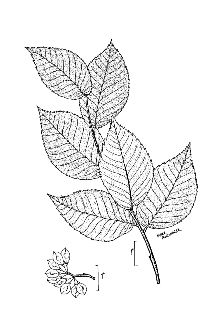Ulmus fulva Michx.
Scientific Name: Ulmus fulva Michx.
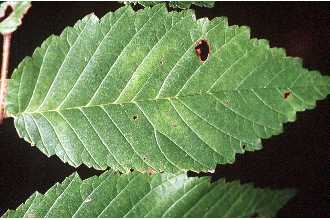
| General Information | |
|---|---|
| Usda Symbol | ULFU |
| Group | Dicot |
| Life Cycle | Perennial |
| Growth Habits | Tree |
| Native Locations | ULFU |
Plant Guide
Alternate Names
Red elm
Uses
Ethnobotanic: This tree was valued for its bark, which supplied material for the sides of winter houses and roofs of the Meskwaki. The inner bark was used for cordage by many tribes. The Menomini gathered the bark, boiled it, and used it for making fiber bags and large storage baskets. The Dakota, Omaha-Ponca, Winnebago, and Pawnee used the inner bark fiber for making ropes and cords. Slippery elm was also used extensively as a medicine. The Iroquois scraped the bark of the tree and used it in combination with other plants to treat infected and swollen glands. The inner bark was made into an eye wash for sore eyes. The Menomini used the inner bark in a tea and it was taken as a physic. The inner bark was used by the Menomini and the Meskwaki in a poultice to heal sores on the body. Meskwaki women drank a tea of the bark to make childbirth easier. The tree also was used by the Ojibwe to treat sore throats. The fresh inner bark was boiled and the Dakota, Omaha-Ponca, and other tribes drank the resulting decoction as a laxative. The indigenous people generously taught some of these uses to early non-Indian settlers. Today slippery elm is found in health food stores and is used to relieve sore throats, coughs and other bronchial ailments, and used as a laxative. The wood is used commercially for making furniture, paneling, and containers. Wildlife: Birds often nest in the thick elm foliage, and the seeds and buds are food to songbirds, game birds, and squirrels. Deer and rabbits browse on the twigs.
Status
Robert Mohlenbrock USDA, NRCS, Wetland Science Institute @ PLANTS Please consult the PLANTS Web site and your State Department of Natural Resources for this plant’s current status, such as, state noxious status, and wetland indicator values.
Description
General: Elm Family (Ulmaceae). This graceful, arching tree reaches 20 m, with twigs that are scabrous-pubescent. It can live to be 200 years old and is identified by its "slippery" inner bark. The winter-buds are densely covered with red-brown hairs. The leaves are oblong to obovate, thick and stiff and 10-20 cm. They are pinnately veined and not equilateral. The flowers are subsessile in dense fascicles with 5-9 stamens. They appear before the leaves in the spring. The fruit is a flat, 1-seeded samara. It is suborbicular, 1.5-2 cm and pubescent over the seed.
Distribution
For current distribution, please consult the Plant Profile page for this species on the PLANTS web site, This plant is found in moist woods, in southern Maine and southern Quebec to eastern North Dakota, and south to Florida and Texas, Use soil moisture sensors to measure the soil moisture of Ulmus fulva Michx..,
Establishment
Propagation by seeds: Slippery elm samaras can be gathered when green and ripe from April to June, by sweeping them up from the ground soon after they fall or by knocking the branches with poles and collecting seeds that fall onto tarps. The seeds should then be air-dried for several days, but too much drying can reduce germination. Sow the seeds in flats as soon as they are mature. Sow them with their wings, as de-winging them damages them. There are approximately 90 seeds per gram. Seeds sometimes show dormancy and if so, need stratification. They should be stratified at 41° F for 60-90 days in a moist medium. If storing the seeds before planting, for best results, store them at low moisture content in sealed containers at cool temperatures. Seedlings are susceptible to damping off. In the seedling stage, transplant them into larger containers. The seeds can also be directly planted in the garden and the tree grows in a range of soil types, but prefers moist, rich, bottomland soils. This species can become a weed as it tends to inhabit unkempt shrub borders, hedges, fence-rows, and other open ground. It is susceptible to Dutch elm disease, but not to the degree of American elm. Propagation by cuttings: take cuttings in early summer and root with IBA treatment. Cultivars, Improved and Selected Materials (and area of origin) This species is somewhat available through native plant nurseries within its range.
Plant Traits
Growth Requirements
| Temperature, Minimum (°F) | -43 |
|---|---|
| Adapted to Coarse Textured Soils | Yes |
| Adapted to Fine Textured Soils | Yes |
| Adapted to Medium Textured Soils | Yes |
| Anaerobic Tolerance | Low |
| CaCO3 Tolerance | Low |
| Cold Stratification Required | Yes |
| Drought Tolerance | Medium |
| Fertility Requirement | Medium |
| Fire Tolerance | Low |
| Frost Free Days, Minimum | 90 |
| Hedge Tolerance | None |
| Moisture Use | High |
| pH, Maximum | 7.5 |
| pH, Minimum | 5.0 |
| Planting Density per Acre, Maxim | 800 |
| Planting Density per Acre, Minim | 300 |
| Precipitation, Maximum | 83 |
| Precipitation, Minimum | 21 |
| Root Depth, Minimum (inches) | 40 |
| Salinity Tolerance | None |
| Shade Tolerance | Tolerant |
Morphology/Physiology
| Bloat | None |
|---|---|
| Toxicity | None |
| Resprout Ability | Yes |
| Shape and Orientation | Erect |
| Active Growth Period | Spring and Summer |
| C:N Ratio | High |
| Coppice Potential | Yes |
| Fall Conspicuous | No |
| Fire Resistant | No |
| Flower Color | Yellow |
| Flower Conspicuous | No |
| Foliage Color | Green |
| Foliage Porosity Summer | Moderate |
| Foliage Porosity Winter | Porous |
| Foliage Texture | Coarse |
| Fruit/Seed Conspicuous | No |
| Nitrogen Fixation | None |
| Low Growing Grass | No |
| Lifespan | Moderate |
| Leaf Retention | No |
| Known Allelopath | No |
| Height, Mature (feet) | 85.0 |
| Height at 20 Years, Maximum (fee | 45 |
| Growth Rate | Rapid |
| Growth Form | Single Stem |
| Fruit/Seed Color | Brown |
Reproduction
| Vegetative Spread Rate | None |
|---|---|
| Small Grain | No |
| Seedling Vigor | High |
| Seed Spread Rate | Moderate |
| Fruit/Seed Period End | Spring |
| Seed per Pound | 41000 |
| Propagated by Tubers | No |
| Propagated by Sprigs | No |
| Propagated by Sod | No |
| Propagated by Seed | Yes |
| Propagated by Corm | No |
| Propagated by Container | Yes |
| Propagated by Bulb | No |
| Propagated by Bare Root | Yes |
| Fruit/Seed Persistence | No |
| Fruit/Seed Period Begin | Spring |
| Fruit/Seed Abundance | High |
| Commercial Availability | Routinely Available |
| Bloom Period | Late Winter |
| Propagated by Cuttings | No |
Suitability/Use
| Veneer Product | No |
|---|---|
| Pulpwood Product | Yes |
| Post Product | No |
| Palatable Human | No |
| Palatable Graze Animal | Low |
| Palatable Browse Animal | Low |
| Nursery Stock Product | No |
| Naval Store Product | No |
| Lumber Product | Yes |
| Fuelwood Product | Low |
| Fodder Product | No |
| Christmas Tree Product | No |
| Berry/Nut/Seed Product | No |


